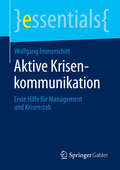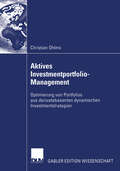- Table View
- List View
Aktiv und konsequent führen: Gute Mitarbeiter sind kein Zufall
by Marijan KoselFührungskräfte aller Ebenen in Unternehmen, auch in öffentlichen Verwaltungen, erhalten einen soliden Werkzeugkoffer mit den wichtigsten Instrumenten der Personalführung. Checklisten, Arbeitsbögen und hilfreiche Fallbeispiele konkretisieren den ganzheitlichen Ansatz für den betrieblichen Alltag.
Aktiv verkaufen am Telefon: Interessenten gewinnen, Kunden überzeugen, Abschlüsse erzielen
by Lothar Stempfle Ricarda ZartmannWas macht Telefonverkäufer erfolgreich? Erstens die richtige Einstellung und zweitens die richtigen Techniken und Methoden – so die Vertriebs- und Kommunikationsexperten Ricarda Zartmann und Lothar Stempfle. „Aktiv verkaufen am Telefon“ zeigt, wie es gelingt, sich optimal auf Gesprächspartner einzu stellen, und begleitet den Leser Schritt für Schritt durch die Phasen eines telefonischen Verkaufsgesprächs. Telefonverkäufer und Call Center Agents erfahren, wie sie sich professionell auf das Telefonat vorbereiten, die Phasen des Gesprächs erfolgreich gestalten und den Kontakt gezielt nachbereiten. Mit Beispielskripten und konkreten Tipps für die wichtigsten Gesprächssituationen am Telefon: Neukundenakquisition, Terminvereinbarung, Nachfassen von Angeboten, Preisgespräche, Reklamationsgespräche, Kundenrückgewinnung und Mahngespräche. Ein wertvoller Praxisleitfaden für alle, die professionell telefonieren und ihre Verkaufsquote am Telefon dauerhaft verbessern wollen. Neu in der 2. Auflage: Kundengewinnung mit Provozierendem Problemlösungsverkauf
Aktiv verkaufen am Telefon: Interessenten gewinnen - Kunden überzeugen - Abschlüsse erzielen
by Lothar Stempfle Ricarda ZartmannDieser Ratgeber begleitet Verkäufer und Call Center Agents Schritt für Schritt durch die verschiedenen Phasen eines telefonischen Verkaufsgesprächs: von der Gesprächsvorbereitung über die Gesprächseröffnung, das Kerngespräch und den Geprächsabschluss bis hin zur Nachbereitung. Die Leser lernen Techniken kennen, die sie sofort in ihrer täglichen Telefonverkaufspraxis umsetzen können. Extra: exemplarische Telefonskripten und Mustergespräche. Wertvolle Tipps für alle, die ihr Gegenüber am Telefon noch besser überzeugen wollen.
Aktiv verkaufen im Premium-Segment: Wie Sie Top-Kunden für hochpreisige Angebote gewinnen
by Alexander Verweyen Gregor EckertAlexander Verweyen und Gregor Eckert, beide renommierte Vertriebs-Consultants, zeigen in ihrem Buch, welche speziellen Erwartungen anspruchsvolle und finanzstarke Kunden haben, welche Werte für sie am wichtigsten sind und welche besonderen Herausforderungen sich daraus für Sie als Verkäufer und Ihre Produktpositionierung ergeben.
Aktive elektronische Dokumente in Telekooperationsumgebungen: Konzept und Einsatzmöglichkeiten am Beispiel elektronischer Patientenakten (Informationsmanagement und Computer Aided Team)
by Stefan WilczekStephan Wilczek greift den Gedanken des gemeinsamen Materials auf und entwickelt ein Konzept aktiver Dokumente. Am Beispiel der elektronischen Patientenakte demonstriert er, wie aktive Dokumente Kooperationsprozesse im Krankenhaus unterstützen können.
Aktive Karrierestrategie: Erfolgsmanagement in eigener Sache
by Hans BürkleDas Buch bietet umfangreiches, auf die praktische Umsetzung ausgerichtetes Wissen, das der Autor in seiner langjährigen Tätigkeit als Karriere- und Strategieberater gesammelt und systematisiert hat. Die entscheidenden Fragen lauten: Wo kann ich mit meinen speziellen Fähigkeiten den größten Nutzen stiften? Und wo liegt folglich meine persönliche Marktlücke?Hans Bürkle vermittelt sein Know-how praxisnah, verständlich und leicht umsetzbar. Für die Neuauflage hat der Autor sein Werk komplett aktualisiert und erweitert. Auch die neuesten Entwicklungen am Arbeitsmarkt einschließlich der Jobbörsen wurden berücksichtigt.
Aktive Krisenkommunikation: Erste Hilfe für Management und Krisenstab (essentials)
by Wolfgang ImmerschittIn diesem Essential erfahren Sie, wie Sie Ihr Unternehmen strategisch, organisatorisch und kommunikativ auf Krisensituationen vorbereiten und in einer akuten Krise professionell agieren. Gezeigt wird, wie Abläufe, Verantwortlichkeiten, Verständigungsketten und Leitfäden für die Kommunikatoren festgelegt werden und wie das Informationsbedürfnis von Stakeholdern erfüllt wird. Denn immer mehr Unternehmen sehen sich plötzlich mit abrupten externen und internen Veränderungen konfrontiert. Breiter Raum wird den Aufgaben des Krisenstabs und der Erstellung des Krisenhandbuchs gewidmet, das Anweisungen, Checklisten und Kontaktdaten für den Notfall enthält.
Aktive Kundenbeziehungen mit CRM: Strategien, Praxismodule und Szenarien
by Harry WesslingDie richtigen Kunden mit dem richtigen Angebot zur richtigen Zeit über den richtigen Kanal in zufrieden stellender Weise zu bedienen, gehört zu den heutigen Herausforderungen von Unternehmen. Das Buch bietet ein Modulsystem für die tägliche Arbeit - mit Checklisten und praktischen Tipps.
Aktive latente Steuern aus steuerlichen Verlustvorträgen: Ein empirischer Vergleich aktueller UGB-Konzernabschlüsse in Österreich (BestMasters)
by Viktoria OberraderZum neuen Wahlrecht im österreichischen Unternehmensgesetzbuch (UGB), der Aktivierung von Steuerlatenzen auf steuerliche Verlustvorträge, stellt dieses Buch erstmalig eine umfassende theoretische Aufarbeitung sowie empirische Analysen dar. Der Vergleich mit dem deutschen HGB und der IFRS lässt große Ähnlichkeiten erkennen, weshalb die Ergebnisse über das UGB hinaus indizierend sein können. Die Analysen ergeben, dass die neue Möglichkeit bisher zumeist nicht genutzt wird und sich eher größere Konzerne dafür entscheiden. Es fehlen jedoch Angaben, ob freiwillig oder wegen Nichterfüllung von Ansatzvoraussetzungen verzichtet wird, wobei generell ein Aufholbedarf zum Anhang besteht – Best-Practice-Beispiele werden dargestellt. Zudem zeigt sich, dass latente Steuern auf Verlustvorträge im Median 1,61 % des Eigenkapitals betragen.
Aktive Medienarbeit mit Jugendlichen: Theorie und Praxis (Schriftenreihe des Institut Jugend Film Fernsehen #10)
by Fred SchellAktive Produktindividualisierung: Ansatzpunkte zur nutzerorientierten Konzeption von Mass-Customization-Angeboten im Konsumgütermarkt (Schriftenreihe des Instituts für Marktorientierte Unternehmensführung (IMU), Universität Mannheim)
by Anja DüllAktives Ausgleichen von Bike-Sharing-Systemen
by Jan BrinkmannDieses Buch berichtet über einen Betriebsmanagementansatz zur Verbesserung von Bike-Sharing-Systemen durch den Ausgleich von Nachfrageschwankungen. Ziel ist es, die Fahrräder innerhalb des Systems umzuverteilen und so ein "aktives" Gleichgewicht herzustellen. Das Buch beschreibt ein mathematisches Modell sowie datengesteuerte und simulationsbasierte Ansätze. Außerdem wird gezeigt, wie diese Elemente in einem System zur Entscheidungsunterstützung für Dienstleistungsanbieter kombiniert werden können. Abschließend wird die entwickelte Methode anhand von realen Daten evaluiert und gezeigt, dass sie erfolgreich Nachfrageänderungen vorhersehen kann und somit eine effiziente Planung von Transportfahrzeugen für die manuelle Verlagerung von Fahrrädern zwischen Stationen unterstützt.
Aktives Investmentportfolio-Management: Optimierung von Portfolios aus derivatebasierten dynamischen Investmentstrategien
by Christian OhlmsChristian Ohlms entwickelt eine neue finanzmathematische Lösung, wie komplexe Investmentziele, die die integrale Einbeziehung von Derivaten, derivatebasierter Investmentstrategien und zeitlicher Dynamik in die Investmentportfolio-Optimierung erfordern, intertemporal erreicht werden können. Ein ausführlicher Praxisteil zeigt die Implementierung dieser Lösung in Mathematica.
Aktives Preismanagement
by Sven Reinecke Laura Johanna NollDieses Buch zeigt, wie es gelingt, aus dem «Stiefkind» im Marketing, dem Pricing, jenes Marketinginstrument zu entwickeln, das den Gewinn des Unternehmens am nachhaltigsten positiv beeinflusst. Jegliches Marketing schlägt sich letztlich im Preis nieder, weil der Preis die Gegenleistung des Abnehmers für die anderen drei wertstiftenden Marketinginstrumente ist: das Produkt (funktionaler Wert), die Kommunikation (emotionaler Wert) und die Distribution (Verfügbarkeit). Die Autoren stellen die wichtigsten Rahmenbedingungen und Grundprinzipien eines aktiven Preismanagements vor. Dabei greifen sie jene Aspekte heraus, die sich im Rahmen der Executive Education der Universität St. Gallen (HSG) als besonders relevant für die Unternehmenspraxis bewährt haben.
Aktives Projektmanagement für das Bauwesen: Eine Anleitung zur effektiven Unterstützung, Durchführung und Steuerung von Bauprojekten
by Erik WischnewskiAktives Projektmanagement für den IT-Bereich: PC-gestützte Planung, Durchführung und Steuerung von Projekten
by Erik WischnewskiIT-Projekte stehen heute mehr denn je auf dem Prüfstand. Das Buch hilft in allen Phasen der Projektarbeit, insbesondere bei der Begrenzung und Vermeidung von Termin- und Kostenüberschreitungen. Es hebt sich vom Gros der auf dem Markt erhältlichen Literatur zum Projektmanagement vor allem dadurch ab, dass es effektive Mittel des Controllings und der Steuerung von Projekten vorstellt. Zum Buch gibt es für den Leser einen kostenlosen Online-Service.
Aktivierung im Sportsponsoring: Gestaltung strategischer Partnerschaften aus Sponsorenperspektive
by Dominik SchwizerDominik Schwizer untersucht Aktivierungsstrategien namhafter Sponsoren im Sport und entwickelt konzeptionelle Ansätze zur Gestaltung von Aktivierung in Sportsponsoring-Partnerschaften. Er zeigt Mechanismen und Themenfelder auf, mit denen Sportsponsoring-Partnerschaften aus Sponsorenperspektive gezielt in die Unternehmenskommunikation integriert werden können. Eine Themenlandkarte mit aggregierten Herausforderungen im Sportsponsoring-Management, eine Typologie zur Aktivierung im Sportsponsoring, ein Aktivierungskonzept zur Gestaltung von Sportsponsoring-Partnerschaften und zwei Projektrealisierungen zur Aktivierung im Sportsponsoring sowie praxisnahe Handlungsempfehlungen unterstützen Sponsoring-Verantwortliche bei der Planung, Konzeption und Realisierung einer professionellen Aktivierung von Sportsponsoring-Partnerschaften.
Aktivierung und Überzeugung im Bundestagswahlkampf 2013
by Oliver Strijbis Kai-Uwe SchnappDieses Buch geht in seiner Analyse der Frage nach, welchen Einfluss der Wahlkampf auf das Ergebnis der Bundestagswahl 2013 hatte. Dazu wendet es auf eklektische Weise etablierte Wahltheorien an und verbindet diese mit dem Konzept des "Wahlkampfereignisses". Um die Wählerentscheidungen zu jedem Zeitpunkt des Wahlkampfs nachzeichnen zu können werden die Prognosemarktdaten von politikprognosen.de sowie ein Umfragedurchschnitt der Befragungsunternehmen mit wöchentlicher Befragung (Forsa, Emnid, Infratest) herangezogen.
Aktivitätsklauseln in deutschen Doppelbesteuerungsabkommen: Rechtsfragen und steuerrechtliche Bedeutung (PwC-Studien zum Unternehmens- und Internationalen Steuerrecht)
by Benedikt Christoph LäuferDie von Deutschland in seinen Doppelbesteuerungsabkommen verwendeten Aktivitätsklauseln führen nicht selten beim Rechtsanwender zur Rechtsunsicherheit. Aus ihren unterschiedlichen Ausformungen resultieren Anwendungsschwierigkeiten sowie verfassungs- und europarechtliche Bedenken. Sie sind zum Teil nicht abgestimmt mit anderen Normen des deutschen (internationalen) Steuerrechts. Benedikt Christoph Läufer versucht, Ordnung in diesen Bereich zu bringen. Dabei zeigt er ländervergleichend auf, dass es möglich ist, die bestehenden Aktivitätsklauseln zu vereinheitlichen und damit einen Gewinn an Rechtssicherheit zu erzielen. In einem Formulierungsvorschlag verarbeitet er die aufgezeigten Schwachstellen.
Aktivposten Wissenskapital: Unsichtbare Werte bilanzierbar machen
by Leif Edvinsson Gisela BrünigLeif Edvinsson, weltweit führender Knowledge-Guru, stellt in Zusammenarbeit mit der deutschen Wissensexpertin Gisela Brünig seine innovativen Konzepte des Wissensmanagements vor. Mit vielen Fallbeispielen.
Aktualisierung und Prognose technischer Koeffizienten in gesamtwirtschaftlichen Input-Output Modellen (Wirtschaftswissenschaftliche Beiträge #43)
by Josef RichterGesamtwirtschaftliche integrierte Input-Output Modelle zählen zu den aussagekräftigsten und ambitioniertesten Instrumenten der empirischen Wirtschaftsforschung. Ihr Einsatz wird freilich durch die mangelnde Aktualität der Datenbasis wesentlich eingeschränkt. Die Arbeit unternimmt eine Inventur der Ansätze, die in den wichtigsten Input-Output Modellen zur Aktualisierung und Prognose der Matrix der technischen Koeffizienten Verwendung finden. Diese Inventur berücksichtigt die jeweilige Datensituation in den einzelnen Ländern ebenso wie die unterschiedlichen Aufgabestellungen der einzelnen Modelle. Eine kritische Würdigung der Methoden verschafft einen Überblick über das verfügbare Instrumentarium. Umfangreiche empirische Arbeiten demonstrieren die strategische Bedeutung der adäquaten Abbildung der Produktionstechnologien. Ihre zentrale Stellung sowohl für die Strukturentwicklung als auch für die Entwicklung der gesamtwirtschaftlichen Aggregate wird sowohl durch detaillierte ex-post Simulationen und Analysen als auch durch ex-ante Simulationen illustriert.
Aktuelle Aspekte des Controllings: Festschrift für Hans-Jörg Hoitsch
by Volker Lingnau Hans SchmitzSeit Einführung der ersten Controllerstellen im privatwirtschaftlichen Bereich gegen 1880 in den USA hat das Controlling eine stürmische Entwicklung in der Praxis erlebt, die vielfach als Siegeszug bezeichnet wird. Gleichzeitig stand und steht insbesondere die deutschsprachige Betriebswirtschaftslehre dem Phänomen Controlling eher abwartend bis skeptisch gegenüber. Insbesondere hat sich bislang kein einheitliches Controllingverständnis heraus gebildet. Dementsprechend wird eine Vielzahl von Aufgaben mit dem Controlling verknüpft, die vom Rechnungswesen bis zum De-facto-Management reichen. Prof. Dr. Hans-Jörg Hoitsch, zu dessen 60. Geburtstag dieses Buch als Festschrift erscheint, hat schon früh die Notwendigkeit einer entscheidungsorientierten Controllingfunktion gesehen. Dieses Buch gibt ein Schlaglicht auf die vielfältigen Facetten des aktuellen Controllingsverständnisses.
Aktuelle Aspekte in der Dienstleistungsforschung (Fokus Dienstleistungsmarketing)
by Anton MeyerDer vorliegende Tagungsband präsentiert aktuelle Herausforderungen der Dienstleistungsforschung, die aus verschiedenen Perspektiven beleuchtet werden, und zeigt vielfältige Lösungsansätze auf. Die Relevanz von Dienstleistungen in der Wirtschaft ist unverkennbar. Das Dienstleistungsmarketing und -management hat daher sowohl in der Praxis als auch in der wissenschaftlichen Auseinandersetzung einen herausragenden Stellenwert eingenommen. Es handelt sich um die Beiträge des 17. Workshop Dienstleistungsmarketing, der im November 2013 an der Ludwig-Maximilians-Universität München veranstaltet wurde. Diese Workshops, die sich seit dem Jahr 1991 als Diskussionsplattform der deutschsprachigen Dienstleitungsforschung etabliert haben, leisten wertvolle Beiträge hierzu.
Aktuelle Beiträge zur Dienstleistungsforschung (Fokus Dienstleistungsmarketing)
by Stefan RothDer vorliegende Sammelband umfasst die Beiträge zum 16. Workshop Dienstleistungsmarketing, der im Jahr 2012 vom Lehrstuhl für Marketing an der Technischen Universität Kaiserslautern ausgerichtet wurde. Die Beiträge greifen aktuelle Problemstellungen aus dem Dienstleistungsmarketing auf, die theoretisch-konzeptionell und empirisch-quantitativ beleuchtet werden. Dieser Sammelband liefert damit wichtige Erkenntnisse und Einblicke für Praktiker und Forscher.
























